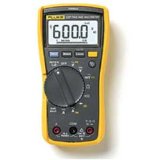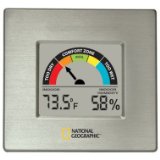

Search This Site
Search With Google
The Hygrometer
Humidity
Moisture Meter Guide
The complete moisture meter website
Humidity is the measurement of water vapour in the air. Water vapour is water that has turned from a liquid in to an invisible gas. The term absolute humidity is the total amount of water vapour that a specified volume of air.
Then we have relative humidity which is the ratio of moisture content that air can hold. This relative humidity will vary depending upon the temperature of the air. Warm air will hold more moisture than cold air.
Humidity affects how we react to a given temperature. If you have a room at the same temperature but with a higher humidity level, we will feel warmer. This is because the body cools itself by sweating. When the air around you contains more moisture levels, the dampness on the skin will not evaporate so easily, making you feel warmer.
It is important to know the levels of humidity, especially indoors because the humidity can effect your health, how comfortable you feel and the condition of most of your household effects.
Moisture Meter Guide 2010 Contact details:garnett65@hotmail.com
The hygrometer is an instrument that can be used for measuring the moisture content in the environmental air. Humidity meters are a range of moisture meters that can monitor the air moisture content in a particular area or specific room in a building. As well as measuring the humidity these meters will also include temperature readings as well. This is because air humidity is closely linked to the relative temperature. How to use a hygrometer
If the indoor humidity in your home is too high, it is natural to think that the room temperature is hot and stuffy, even if the room temperature is at a temperature that is normally comfortable to you. The opposite can be said for too little humidity in the home.
Keeping humidity levels within an optimal range will help to control bacteria, viruses, fungi and allergies. Measuring and keeping records of humidity levels in your home will also inform you as to how well your humidifiers, dehumidifiers and air conditioning are functioning. It is worth noting as well that keeping a proper humidity control in the home will reduce your energy bills as well as helping any indoor equipment perform properly.
Humidity outdoors will also make a difference to how a particular temperature will feel to you. The human body finds it extremely difficult to cope with hot weather where the air humidity is high. It is not possible to control outdoor humidity but knowing relative humidity levels can alert you as to how warm or cold the outside air will feel. Knowing outdoor humidity will inform you whether rain, snow or reduced visibility will occur. If the air has relative humidity of 100% the air is saturated with moisture and will not be able to hold anymore moisture. So even if the air cools just a little, the moisture content will be released in the form of fog or mist.
The Effect Of Humidity In The Home
It is essential to know the humidity level in you home to maintain good air quality and comfort within it.
Too much humidity will invite unwanted guests in such as mold, bacteria and dust mites.
Too little humidity in the home will cause nosebleeds, skin irritation, breathing problems and a large problem with static electricity.
The trick is to try and maintain a healthy balance.
How To Measure Humidity
To measure humidity you need to use a hygrometer. They can be designed for both or either indoor and outdoor use. There are 2 types of hydrometer; analogue and digital.
The analog hygrometer employs a moisture sensitve material which is attached to a coilded spring. This spring will in turn operate a needle on an easy to read display dial. With just a glance you will be able to see any current information about humidity levels. There are many examples of the analog hygrometer and many come combined with thermometers and have different finishes so that they can fit in to your home in a decorative manner.
The digital hygrometer employs a sensor to monitor the electric current which is affected by the moisture content levels in air. The digital hygrometer is more advanced than the analog hygrometer and with one you can keep records of high and low humidity measurements and any trends that occur. They are more precise with their results and do not require manual calibration.
To Control Mold One Must Control Temperature And Humidity
Mold is a form of fungus that can damage your health, your home and your possessions. In order for mold to thrive it requires the right temperature and moisture levels. Mold spores are everywhere and to control them one must control temperature and humidity.
An exposure to indoor mold can make allergies, asthma and respiratory disorders a lot worse. Mold can also irritate the eyes, skin and lungs of very healthy people. As well as affecting health it can also ruin household furnishings.
Being able to measure humidity and control it is a great step forward in preventing mold growth in your home. Mold thrives in the same temperature range that we humans find comfortable. When condensation occurs it will provide ideal conditions for the mold. So you cannot control mold through temperature alone. You also need to control and monitor humidity.
To Care Is To Share




Low Humidity Level
Less than 25 % RH
Causes a dry environment
OK Humidity Level
Between 25 % and 55 % RH
Causes a comfortable environment
High Humidity Level
Over 55 % RH
Causes a humid environment
| Tramex Moisture Encounter Plus |
| Tramex Compact Wood Moisture Meter |
| Tramex Concrete Encounter Moisture Meter |
| Tramex Skipper Plus Moisture Meter |
| Tramex Roof And Wall Moisture Scanner |
| Sonin Digital Moisture Meter model 50218 |
| Sonin Digital Moisture Meter 270 model 50270 |
| Sonin Moisture Test Tool model 50210 |
| Sonin Moisture Test Meter Model 50211 |
| Oak |
| Douglas Fir |
| Beech Tree |
| Elm Tree |
| Hickory Tree |
| Maple Tree |
| Pine Tree |
| Prevent And Repair Gaps In Wooden Floorboards |
| How To Fix A Squeaky Hardwood Floor |
| How To Repair A Hardwood Floor That Has Buckled |
| Which Is The Best Firewood? |
| Concrete |
| Concrete Moisture |
| Screed Moisture Meter |
| SDS Drill |
| Belle Cement Mixer |
| SDS Drill Advice |
| Which SDS Drill |
| SDS Drill Accessories |
| Drilling Into Concrete |
| Kennedy Tool Box |
| Moisture - Basic Facts |
| Types Of Damp |
| Wet Rot |
| Dry Rot |
| Mold |
| Water Leak Detection |
| Stucco Moisture |
| Water Damage |
| Moisture And Rust |
| Moisture Damage To A Chimney |
| Wallpaper Stripper |
| Plaster Mixer |
| Why Worry About Moisture Problems |
| Does Your Home Have A Moisture Problem? |
| How To Solve Moisture Problems |
| How To Use Anti Mold Paint |
| Rising Damp |
| Condensation |
| Salt Damp |
| How To Avoid Bathroom Condensation |
| How To Remove Black Mold |
| How To Prevent Bathroom Mold |
| Soldering Kit |
| Soldering Kit Contents |
| Soldering Kit Advice |
| Bonsai Tree Classification |
| Growing Bonsai From Seed |
| Bonsai Tree Care |
| Bonsai Tree Training |
| Bonsai Tools |
| Displaying Bonsai |
| Bonsai Calendar |
| Bonsai Plants |
| The Thirsty Light Curve Moisture Meter |
| The Thirsty Light Ladybird Moisture Meter |
| The Thirsty Light Bumble Bee Moisture Meter |
| The Thirsty Light Butterfly Moisture Meter |
| Hanna Instruments |
| Agratronix Portable Coffee Moisture Tester |
| Lawn Aerator |
| Lawn Roller |
| Lawn Rake |
| Lawn Sand |
| Chainshot |
| Chainsaw Gloves |
| Chainsaw Trousers |
| Chainsaw Boots |
| Mac 4 - 20 XT Chainsaw |
| Mac 738 Chainsaw |
| Mac 842 Chainsaw |
| Mac 20X Power Chainsaw |
| Einhell BG-PC 3735 Chainsaw |
| Einhell BG-PC 4040 Chainsaw |
| Einhell BG-PC 5045 Chainsaw |
| Poulan P3314 Chainsaw |
| Poulan P4018 Chainsaw |
| Poulan Pro PP3816AV Chainsaw |
| Poulan Pro PP4218AVX Chainsaw |
| Poulan Pro PP4620AVX Chainsaw |
| Efco MT 4100 SP Chainsaw |
| Efco MT 3500 Chainsaw |
| Efco 132 S Chainsaw |
| Efco 147 Chainsaw |
| Efco 152 Chainsaw |
| Efco MT 7200 Chainsaw |
| Efco MT 8200 Chainsaw |
| Efco MT 3750 Chainsaw |
| Methods Of Obtaining Soil Moisture Levels |
| Hygrometer |
| Psychrometer |
| Rain Gauge |
| Wave Ventilation System |
| Humidity |
| Hygrometer For Keeping Reptiles |
| Humidor |
| Weather Stations |
| Musical Instrument Storage |